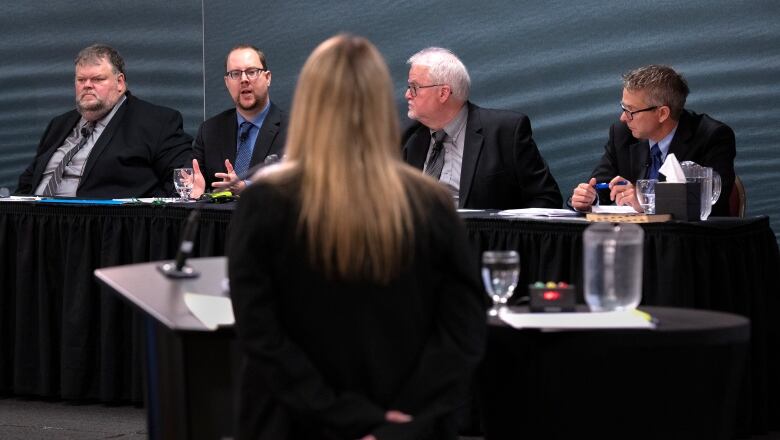Issues with radio communications have become a theme in the inquiry into the mass shooting across Nova Scotia in April 2020, but recent evidence points to user error playing the biggest role.
A roundtable last week on the digital radio system in Nova Scotia used by police and other first responders went over the technical aspects of the system and what happened across April 18 and 19, 2020 when a gunman killed 22 people in the province.
“After the incident … it became apparent that some of the functions of the radio weren’t, I would say, widely understood or weren’t being exercised,” Christian Gallant, divisional information management and technology officer with the Nova Scotia RCMP, told the Mass Casualty Commission leading the inquiry Thursday.
Gallant said his role involves overseeing the radio program and training around that technology for the RCMP.
Various front-line and commanding officers have told the inquiry they experienced issues while trying to speak into their portable radios to share important updates or get direction.
During the incident at the Onslow fire hall, two RCMP officers Const. Terry Brown and Const. Dave Melanson mistakenly opened fire on a civilian who they thought was the rampaging gunman.
Melanson testified last month that he and Brown decided to fire after he failed to get through on his portable radio and receive instructions from commanders. The inquiry found that he made eight failed attempts to contact commanders using the radio system.
A report on the incident that was released in March 2021 by Nova Scotia’s police watchdog agency cleared the Mounties of wrongdoing and largely blamed jammed radio communications for what transpired.
The Serious Incident Response Team said the “sole reason” the officers couldn’t transmit before opening fire was because “there was no available talk path due to the heavy volume of radio traffic.”
However, Trevor MacLeod, Bell Mobility’s director of public safety radio engineering and operations, said Thursday that the radio system was functioning as it should.
Although radio calls tripled compared to a regular weekend on the morning of April 19 on the tower closest to Portapique and other scenes, MacLeod noted the system was never beyond its capacity.

If any radio users got busy signals while trying to speak, MacLeod said their call would be placed in a queue, but within “seconds” they would have gotten a pinging sound notifying them they could now talk.
It’s unclear if Brown and Melanson, or other officers, properly used the emergency request to talk button, or ERTT, during the incident.
Roundtable members explained that when the bright orange button is hit, the radio user can speak immediately — even if they had been getting busy signals before.
The radio user would be able to speak for 20 seconds uninterrupted, and the operational communications centre handling 911 calls and RCMP dispatch would also be notified of that message as it was coming in.
Glen Byrne, commander of the communications centre, told commission investigators in an interview last summer that he’d heard from his staff “numerous times” that some RCMP members didn’t know how to use their radios.
“A member puts a radio on their … on their belt and on a 12-hour shift, they’re probably interacting with that radio … hundreds of times. Yet they don’t know the functionality of the radio or how it works or why it works,” Byrne said.
“That’s insane … a radio’s going to save a member’s life before their gun is.”
RCMP have to hit certain button
Operational communications centre staff often direct Mounties in how to switch between channels and get onto the correct talk group, Byrne said. He called that “a problem.”
The inquiry has heard talk groups are like a radio chatroom where multiple agencies can talk freely, and also securely if the group is encrypted.
The inquiry also heard Thursday about the importance of the RTT (request to talk) button, which signals to dispatchers at the operational communications centre that a RCMP member has a message for them.
Unlike the communications centre in Halifax that dispatches both RCMP and municipal forces within the Halifax region, the OCC doesn’t live-monitor radio traffic because it handles so many members and talk groups across the province, according to documents released by the inquiry.
It is unclear whether officers sharing key pieces of information used that RTT button, like Const. Vicki Colford broadcasting that she’d been told of a back way out of Portapique the night of April 18.
The inquiry has heard that is likely not the case, since no dispatcher responded to Colford at the time, and the RCMP risk manager at OCC also said he didn’t hear it.
Byrne said in his interview more radio education is needed, and suggested that a full radio training course should be done for RCMP members every year, rather than every four years as is the case now.
New weekly emergency button testing
Although the training material itself hasn’t changed much since the mass shooting, Gallant said Thursday the RCMP now has weekly ERTT testing with members so they can experience what it’s like to use the emergency call button.
A document on radio communications prepared for the inquiry said that practice exercises and equipment testing also continue to occur weekly between municipal police forces and the RCMP.
The OCC offers a weekly check-in, where any law enforcement radio user can practise switching their radio channel to a talk group.
Regular physical practice of using the radio and getting used to its sound alerts and features is key for police officers so they don’t waste time during a crisis, Matthew Boyle, a director of Public Safety & Field Communications for the province, said Thursday.
“There’s other things going on around them, there’s activity and noise and distractions and so on, so that’s where the muscle memory becomes really important,” Boyle said.
Boyle said that PSFC handles the radio system in Nova Scotia, and develops overall training, but leaves it up to agencies like the RCMP to carry it out internally.

The issue of air support radio communications was also brought up Thursday.
The inquiry has heard that Byrne and the pilot in the Department of Natural Resources helicopter helping in the search for the gunman on April 19 couldn’t get on the same secure channel, and had to settle for an unencrypted one.
When the air support communications issue was happening the morning of April 19, Boyle said he was monitoring the radio and reached out to the RCMP to suggest Byrne and the pilot get on the same encrypted talk group.
Later, Boyle said they realized the issue was timing — both Byrne and the pilot accessed the secure channel, but not at the same time, so they thought it wasn’t working.
Byrne said in his interview that OCC is now doing regular testing with provincial pilots.
Although Boyle said his team didn’t reach out again on April 19 to help manage the radio communications because they weren’t in the loop about what was going on, he suggested in future they could be brought into major events earlier to help where they can.
The inquiry also heard Thursday that a radio in the gunman’s replica RCMP vehicle was an older model that would not have had the capacity to listening in to the digital radio network used by the RCMP during the shooting.
But during followup questioning by commissioner Leanne Fitch, Boyle said it would have been possible to monitor older analog radios used by organizations like fire departments.
“That would be technically possible. Of course, I can’t speculate as to whether or not that many have been the case,” Boyle said.
The inquiry resumes Monday in Dartmouth, when small group discussions will take place with others involved in the mass shooting response.













Leave a comment